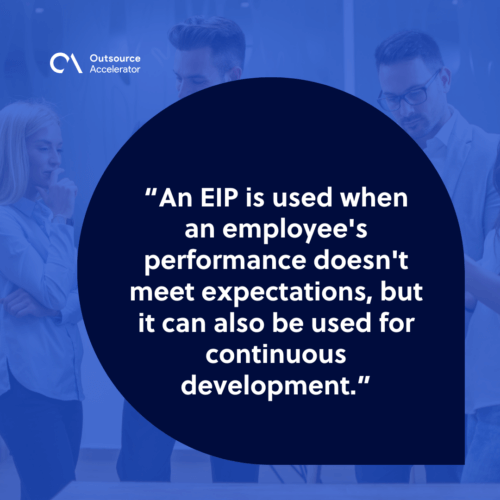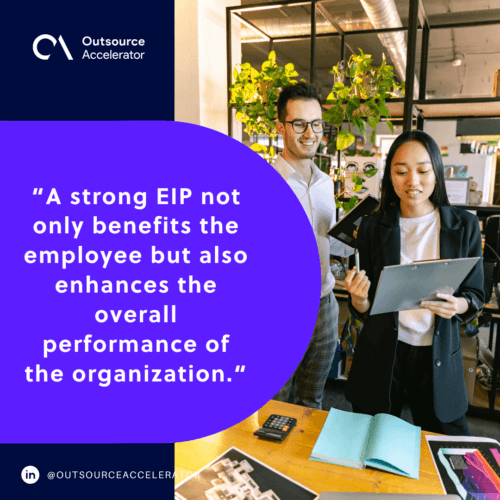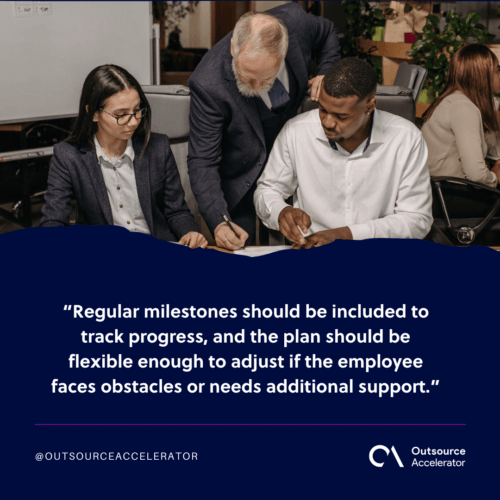A step-by-step approach to creating impactful employee improvement plan

Companies must recognize that the growth and development of their employees go hand in hand with their overall success. Focusing on both career and character advancements not only empowers employees but also drives productivity, engagement, and retention.
When employees are given opportunities to develop new skills, overcome challenges, and enhance their professional behaviors, they become more invested in the organization’s success.
This holistic approach to employee growth helps strengthen the company’s culture, boost performance, and create a more motivated workforce.
One powerful tool that businesses can use to support this growth through a well-structured plan. This plan is designed to guide employees toward achieving both personal and professional improvements.
It helps align individual goals with organizational objectives, creating a path for mutual success.
In this article, we provide a practical, step-by-step guide for creating an impactful employee improvement plan that can foster growth and deliver lasting results.
What is an employee improvement plan?
An employee improvement plan (EIP) is a structured and formalized process designed to help employees to:
- Enhance their performance
- Develop new skills
- Address any areas where they may be underperforming
Typically, an EIP is used when an employee’s performance doesn’t meet expectations, but it can also be used for continuous development.
The plan outlines specific goals, timelines, and support resources, providing clear steps for employee development.

Key elements of an employee improvement plan
An employee improvement plan must incorporate the following:
- Performance assessment – This is a clear evaluation of the staff’s current performance, identifying strengths and areas for improvement.
- SMART goals – These are specific, measurable, achievable, relevant, and time-bound goals that provide a roadmap for improvement.
- Action plan – This is a detailed set of steps and actions to achieve the improvement goals, including resources, training, or support needed.
- Timeline and milestones – It must have a clear timeline for achieving objectives, with regular check-ins to assess progress.
- Feedback and support – It should also involve ongoing feedback from managers, as well as any mentorship or resources the employee may need.
- Outcome evaluation – You need a process for assessing the success of the improvement plan and determining the next steps once the goals are met or the plan concludes.
EIPs are not only a way to address performance issues but also to encourage success and align personal aspirations with organizational objectives. Ultimately, they should demonstrate that the company is invested in the employee’s success.
5 steps for a viable employee improvement plan
A well-crafted EIP helps guide employees toward their career journey. Below, we outline five essential steps in setting up a viable employee improvement plan:
1. Assess the employee’s current performance
The first step in any improvement plan is a comprehensive evaluation of the employee’s current performance. This involves identifying specific areas where the employee is struggling, as well as recognizing their strengths.
Managers can use performance reviews, 360-degree feedback, self-assessments, and direct observations to gather relevant data.
It should pinpoint performance gaps, whether they are related to skills, attitude, behavior, or work habits. They must dig deep to understand the underlying causes of these issues.
The assessment forms the foundation of the EIP.
2. Set clear and achievable goals
Once performance gaps have been identified, the next step is to establish clear, achievable goals. Following the guidelines of SMART, these should be specific, measurable, achievable, relevant, and time-bound goals.
Collaborating with the employee to set these goals is critical, as it encourages ownership and ensures that the objectives are meaningful and motivating.
The aim should be directly aligned with both the employee’s development needs and the organization’s overall objectives.
Clear, measurable goals give employees a tangible target to work upon. Without these defined objectives, there’s no clear way to track progress or measure success.
3. Develop an action plan
The action plan is the roadmap that outlines how the employee will achieve the established goals. It includes specific tasks, milestones, deadlines, and resources required for success.
This may involve additional training, mentorship, job shadowing, or new responsibilities to help the employee build the skills necessary to improve.
Regular milestones should be included to track progress, and the plan should be flexible enough to adjust if the employee faces obstacles or needs additional support.
4. Provide ongoing support and feedback
An employee improvement plan is not a one-time event; it requires consistent and ongoing support from managers.
Constructive feedback is crucial so the employee stays on track and has the guidance they need.
Support might include additional resources, training opportunities, or mentorship. It’s also important to maintain open communication so employees feel comfortable asking questions and seeking help when needed.
Continuous support and feedback provide motivation and prevent disengagement.
Regular check-ins allow managers to address any challenges early and adjust the plan if needed. Doing so allows employees to feel supported throughout the process.
5. Evaluate success and adjust the plan if needed
The final step is to evaluate the employee’s progress toward the goals outlined in the plan. This involves reviewing both quantitative and qualitative results, such as:
- Performance metrics
- Feedback from colleagues
- Employee’s own perspective
If the staff members have met the goals, it’s important to recognize their success and celebrate achievements. However, if progress is insufficient, the plan may need to be adjusted.
Evaluating success helps determine whether the EIP has been successful or not. It’s a way for companies to determine whether employees are on the right path and if the organization’s investment in their development is yielding results.
Why an effective employee improvement plan matters
Here are five key advantages of having a robust EIP in place:
1. Enhanced employee performance
A well-defined EIP helps employees understand exactly where they need to improve and what is expected of them.
Setting clear, measurable goals provides a roadmap for improving their performance. With regular feedback and actionable steps, employees can focus on enhancing their skills, which directly contributes to higher productivity and quality of work.
2. Increased employee engagement and motivation
As Gallup’s survey shows, in 2023, 16% of U.S. employees felt more disconnected from their employers than four years ago. They experienced unclear expectations, lower satisfaction, and less connection to their organization’s mission and purpose.
When employees feel supported and see that their development matters to the organization, they are more likely to be engaged and motivated.
An EIP demonstrates that the company cares about their personal and professional growth.
By offering guidance and opportunities for improvement, organizations foster a sense of value and loyalty in their employees.
3. Clear path for career development
A robust EIP not only addresses current performance issues but also provides employees with a clear path to their future. It helps teams see how their work aligns with the company’s goals and what skills or behaviors they need to develop to advance further.
This clarity can boost their confidence and help them focus on the next steps in their career journey.
4. Reduced employee turnover
According to a recent report by Hubstaff, 95% of HR professionals identified job burnout as the primary reason for the loss of valuable employees.
A structured improvement plan can help prevent frustration and burnout, leading to higher retention rates.
When performance issues are addressed early and employees receive the necessary support to improve, the likelihood of turnover decreases. Instead of feeling neglected or unsupported, employees are given the tools and resources they need to succeed.
5. Better organizational performance
A strong EIP not only benefits the employee but also enhances the overall performance of the organization. As employees work on their skills and capabilities, the company experiences a more productive, competent workforce.
This contributes to better results, higher customer satisfaction, and a stronger competitive position in the market.

Pitfalls to avoid when creating an employee improvement plan
Steer clear of the following when setting up an employee improvement plan:
- Setting unrealistic or vague goals. Vague or overly ambitious goals can lead to frustration and confusion.
- Focusing only on the negative. To keep people motivated and upbeat, emphasize both your strengths and your room for development.
- Not involving the employee. Include the staff in planning to ensure buy-in and alignment with their career aspirations.
- Lacking support and resources. Make sure the workforce has the tools, training, or mentorship needed to succeed in their improvement plan.
- Neglecting regular follow-up. Schedule consistent check-ins to review progress, provide feedback, and make adjustments as needed.
- Not adjusting the plan. Be flexible and willing to adjust the plan if it’s not working or if new challenges arise.
- Overlooking organizational context. Align the employee’s goals with the company’s objectives to ensure they contribute to broader success.
- Using the plan as punishment. To avoid creating resentment, frame the improvement plan as a growth opportunity, not a disciplinary measure.
A structured approach lets businesses create a positive environment where employees feel valued and motivated to improve.
Finding a way around the common pitfalls keeps the process focused on development, leading to better outcomes for both the employee and the organization.
With the right mindset and strategy, an EIP can drive meaningful change and contribute to present and future success.








 Independent
Independent




